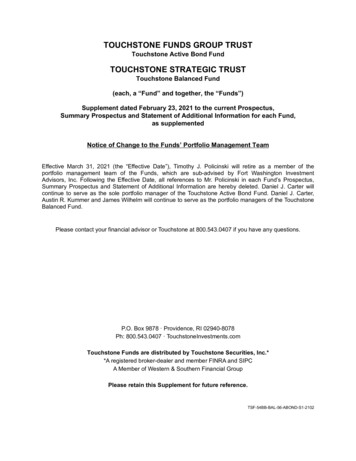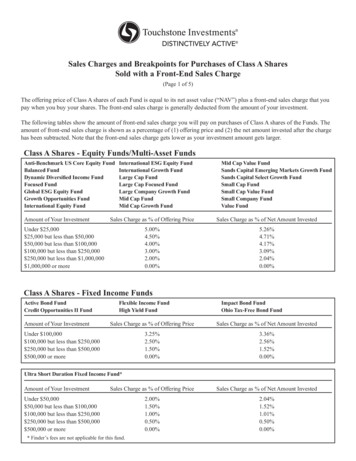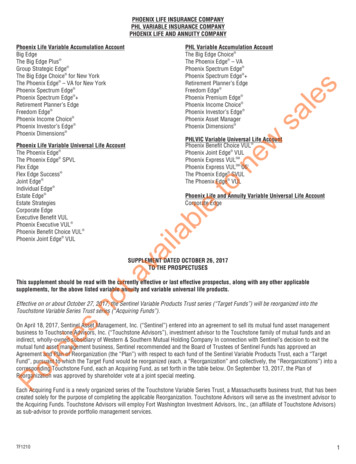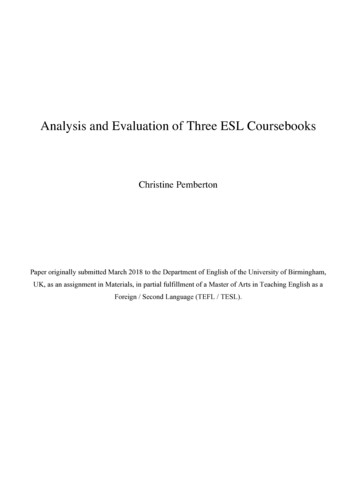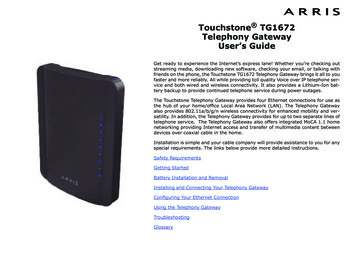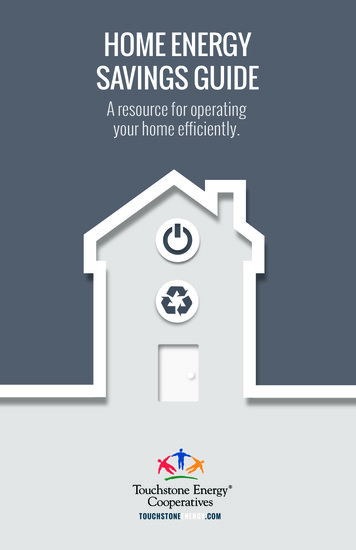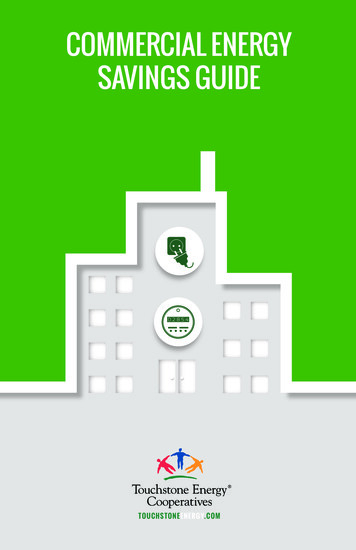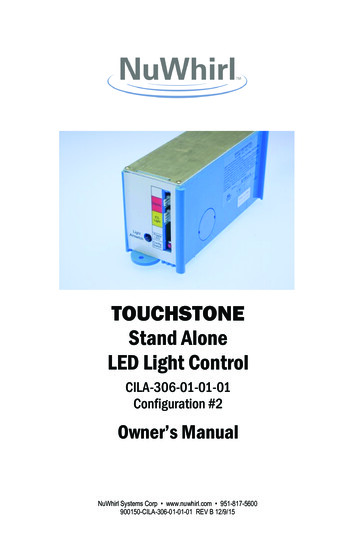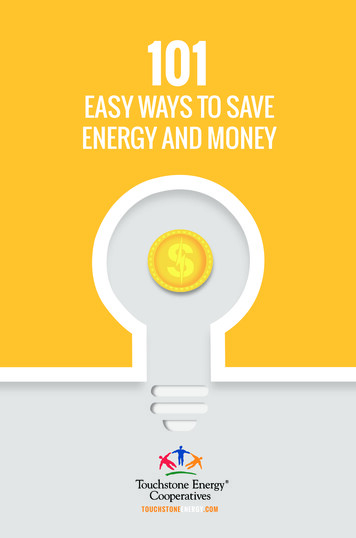
Transcription
101EASY WAYS TO SAVEENERGY AND MONEYTOUCHSTONEENERGY.COM
CoolingWater heatingLightingAppliance21%HeatingElectronicsWHERE DOES MYMONEY GO?29%13%13%12%12%Electronics include: telephone andexternal power adapters, consumerelectronics (computer, TVs and DVDplayer), home office equipment, andsmall appliancesAppliances include: refrigerator,dishwasher, clothes washer anddryer2Source: Typical House Factoid Memo. Lawrence Berkeley National Laboratory.April 2013.Annual Energy Bill fora typical single familyhome is 2,060TOUCHSTONE101ENERGYWAYS TO 101SAVEWAYS TO SAVE
TOP TENHere are ten tips that any good energy saver should not live without.1. Replace any light bulb, especially ones that burn more than one hour per day, with a lightemitting diode (LED) bulb.2. Seal from the inside. Air sealing is an inexpensive way to lower energy costs and improvecomfort. Seal gaps and holes in walls, floors, and ceilings with caulk or foam sealant.Look for cracks around windows and where wires and pipes pass through.3. Plug electronic devices such as cable boxes, printers and TVs into power strips to turn offduring vacations or long periods without use. Smart power strips make it an easy task tosave money.4. Close shades and drapes during the day to help keep your home cooler in the summer andwarmer in the winter.5. Change your central HVAC system filter when dirty by the manufacturersrecommendations. Dirty filters can impact your home comfort and increase yourelectricity bill.6. A one degree increase in heating setpoint or reduction in cooling setpoint can increaseenergy use by 3 – 5%.7. Have your duct work checked for leaks. Leaks at the return, air handler and supply canbe a major source of high bills. Mobile homes check at the grill, cross over duct and downflow air handler, for leaks.8. Set both the upper and lower water heater thermostats no higher than 120 F.9. An electric space heater can cost more than 100 per month to operate. Minimize theiruse, except for limited or temporary spot heating. Turn space heaters off when leaving theroom.10. Ensure refrigerator door seals are tight. Eliminate unnecessary refrigerators.TOUCHSTONEENERGY.COM3
LIGHTINGTraditional lighting can amount up to 12% of your monthly energy use. Energy saving lightbulbs can slice lighting costs by 75%.11. Replace outdoor lighting with its equivalant outdoor-rated LED bulb. LED’s work well incold weather.12. Use fixtures with electronic ballasts and T-8, 32-watt fluorescent lamps.13. Use outdoor security lights with a photocell and/or a motion sensor.14. Turn off unnecessary lighting.A lumen is a unit used for the measurement of visible light. A traditional 60 Watt lightbulb produces 800 lumens. See the chart below to see how many Watts other bulbs use toproduce the same amount of light.0Watt usage2040800 lumensIncandescent bulb60 WattsCFLLED413 Watts7 Watts101 WAYS TO SAVE
PLUG LOADSOther plug loads around the home can add up to be 8-10% of monthly energy use.15. Turn computers and monitors off when not in use.16. When buying a new computer, consider buying a laptop. It uses less energy than acomparable desktop.17. Turn large-screen TVs off completely when not in use.18. Check for energy saving settings on flat-panel TVs like automative brightness controland a power saving sleep mode.19. Request an ENERGY STAR set-top box from cable or satellite provider.20. Turn off stereos and radios when not in use.21. Enable auto power down feature on gaming consoles.22. If you don’t unplug them, use energy-saving modes or automatic sleep function onelectronics.23. Remember to turn off hair curling irons and hot rollers.24. Make sure electric blankets are turned off in the morning.25. Ensure all new appliances, electronics and lights are ENERGY STAR labeled.26. Turn off pool pumps and heaters when not needed.27. Verify livestock water tank heaters are off when not needed.28. Make sure heat tape is off when not needed.29. Unplug battery chargers when not needed.TOUCHSTONEENERGY.COM5
DO A LITTLE.SAVE A LOT.EVERYTHING YOU DO - FROM FLIPPING A SWITCH TOUPGRADING YOUR LIGHTING - CAN ADD UP TO BIGSAVINGS FOR YOU AND YOUR NEIGHBORS.SO TAKE YOUR PICK, AND SAVE YOUR MONEY.6101 WAYS TO SAVE
KITCHENThe kitchen can amount to 15-20% of your monthly energy use, which includes appliance useand refrigeration.30. Turn off coffee makers when not in use.31. Use your refrigerator’s anti-sweat feature only if necessary.32. Switch your refrigerator’s power-saver to “ON,” if available.33. Clean refrigerator coils annually.34. Regularly defrost refrigerator or freezer to avoid ice buildup.35. Set the refrigerator temperature to 34 o - 37oF and freezer temperature to 0o - 5 oF.36. Unplug unused refrigerators or freezers. Recycle them if you do not need them.37. Use microwave for cooking when possible.38. When cooking on the oven range, use pot lids to help-food cook faster.39. If you are heating water on the stove, use hot tap water instead of cold.40. Remember to use the kitchen exhaust fan when cooking. Turn it off after cooking.41. Use a slow-cooker instead of simmering foods on the stove.42. If rinsing dirty dishes before putting them into the dishwasher, do so with cold water.43. Use cold water for garbage disposal.44. Only run dishwasher when fully loaded.TOUCHSTONEENERGY.COM7
WATER HEATINGWater Heating can amount to 12% of your monthly energy use.45. For households with 1 or 2 members, a 115 OF setting may work fine.46. Install water heater wrap, also known as water heater blanket, per manufacturer’sinstructions.47. Drain 1-2 gallons from bottom of water heater each year to reduce sediment build up.48. Install heat traps on hot and cold water lines when it’s time to replace your water heater.49. Insulate exposed hot water lines.50. Limit shower length to 5-7 minutes.51. Install water saving shower heads.52. Fix dripping faucets.53. Don’t let water run while you are shaving or brushing your teeth.8101 WAYS TO SAVE
LAUNDRYLaundry can amount to 5-9% of your monthly energy use.54. Wash clothes in cold water. Use hot water only for very dirty loads.55. Only do full laundry loads.56. If you must do smaller loads, adjust the water level in the washing machine to match theload size, especially when using hot water.57. Always use cold-water rinse.58. Use bath towels at least twice before washing them.59. Clean your dryer’s lint trap before each load.60. Make sure the dryer’s outdoor exhaust door is not blocked or clogged.61. Verify dryer vent hose is tightly connected to inside wall fitting.62. Check that the dryer vent hose is tightly connected to dryer.63. Minimize clothes drying time; use an auto moisture sensor on dryer if available.64. Dry consecutive loads to harvest heat remaining in dryer from last load.65. In hot weather, avoid running the dryer during the heat of the day.66. Consider using a “solar-powered” clothes dryer: an old fashioned clothes line.TOUCHSTONEENERGY.COM9
WEEKEND WARRIOR.HOME EFFICIENCYANALYSIS TOOLBECOME THE ULTIMATE WEEKEND WARRIOR OR WORKWITH A CONTRACTOR TO TAKE YOUR SAVINGS TO THENEXT LEVEL. JUST TELL US A LITTLE ABOUT YOUR HOME.TOUCHSTONEENERGY.COM10101 WAYS TO SAVE
HEATING / ACHeating & Air Conditioning are usually the largest loads in a home and responsible for 4050% of your monthly energy spend.67. Set thermostats to 78o F in summer, 68o F in winter.68. Install a programmable thermostat to save even more.69. Run ceiling paddle fans on medium, blowing down in summer and paddle fans on low,blowing up in winter.70. Turn off ceiling fans when leaving the room. Fans cool people, not rooms.71. When installing new air filters, make sure they are facing in the correct direction (look forarrow on side of filter).72. When heating or cooling, keep windows locked.73. Insulate electric wall outlets and wall switches with foam pads.74. Caulk along baseboards with a clear sealant.75. Caulk around plumbing penetrations that come through walls beneath bathroom andkitchen sinks.76. Caulk electrical wire penetrations at the top of the interior walls in the attic.77. Close shades and drapes at night to keep heat in during the winter.78. Make sure drapes and shades are open during the day to catch free solar heat in winter.79. Ensure attic access door closes tightly and is insulated.80. Make sure insulation in your attic does not block soffit vents.TOUCHSTONEENERGY.COM11
81. Do not close off unused rooms that are conditioned by forced-air systems.82. Do not close supply air registers.83. Check to be sure return air grilles are not blocked by furniture or bookcases.84. Ensure windows and doors are properly weather-stripped and use door sweeps.85. Make sure outside soffit vents are not blocked.86. Do not use roof-top power ventilators for attic exhaust as they may draw conditioned airfrom your home.87. Have your HVAC system serviced once per year by a NATE-certified technician.88. Monitor your home’s relative humidity in the summer. If it consistently stays in the60 percent range or higher, ask your HVAC technician about lowering your central airconditioning unit’s indoor fan speed.89. Ensure window A/C units are weather-stripped. Remove the unit in the winter and closeand lock the window.90. Remove and clean window A/C filter monthly.91. Keep “fresh-air” vents on window A/C units closed.92. Use heavy-duty, clear sheets of plastic sealed tightly on the inside of windows to reducethe amount of cold air entering your home.93. Minimize use of electric space heaters, except for limited or temporary spot heating.Turn space heaters off when leaving.94. Ensure your outdoor heat pump/air conditioning unit is kept clean and free of debris.12101 WAYS TO SAVE12
95. When using the fireplace, turn down your heating system thermostat.95. When using the fireplace open the outside air vent in the fireplace (if provided) or openthe nearest window slightly.96. Keep fireplace dampers closed unless a fire is burning.97. Ensure floor registers are not blocked with rugs, drapes or furniture.98. Caulk around storm windows and basement windows.99. Verify your ducts are tightly connected to your HVAC equipment. Well sealed andinsulated ducts can save up to 10%.100. Turn off bathroom and kitchen exhaust fans 15 minutes after the job is complete orinstall 15-minute timers on bathroom ventilator fans.101. Plant trees and shrubs to provide shade on the east, south and west sides of your home.Evergreen trees and shrubs can provide a windbreak on the north side.TOUCHSTONEENERGY.COM
NOTESFIND OUT MORE ABOUT YOUR NOT-FOR-PROFITELECTRIC COOPERATIVE.TOUCHSTONEENERGY.COM14101 WAYS TO SAVE
For more information, please contact your local TouchstoneEnergy cooperative or visit TouchstoneEnergy.comRevised January 2019TOUCHSTONEENERGY.COM
2 TOUCHSTONE ENERGY 101 WAYS TO SAVE 101 WAYS TO SAVE Source: Typical House Factoid Memo. Lawrence Berkeley National Laboratory. April 2013. Electronics Heating Cooling Water heating Lighting Appliance 21% 29% 13% 13% 12% 12% Applian
